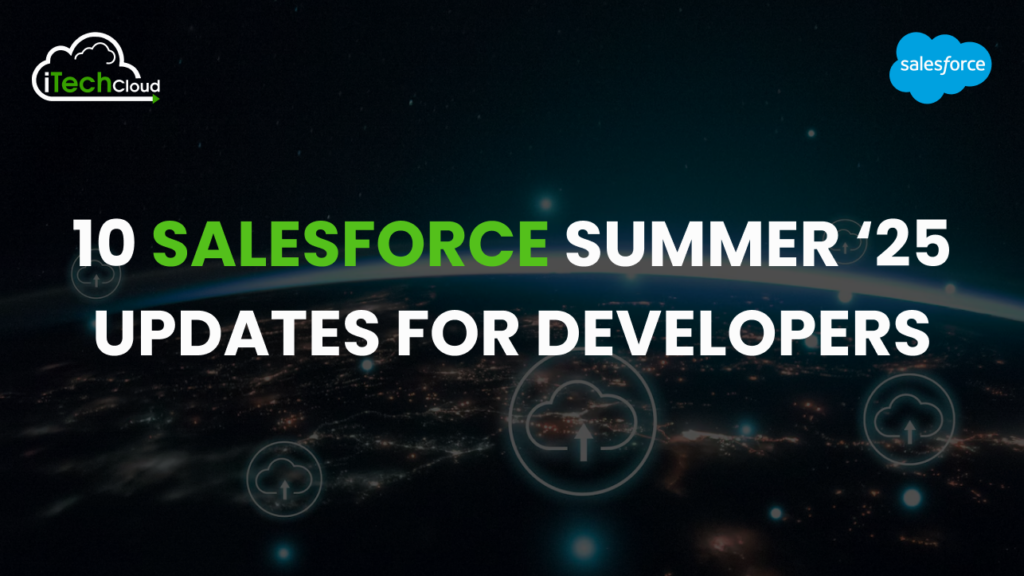10 Salesforce Summer ‘25 Updates for Developers

Salesforce continues to evolve, offering developers powerful new tools and enhancements to streamline development, improve performance, and enhance security. The Summer ‘25 release brings exciting updates across multiple areas, including Apex, Lightning Web Components (LWC), DevOps, AI integrations, and more.
In this blog, we’ll dive into the top 10 Salesforce Summer ‘25 updates for developers, providing insights into how these changes can improve your development workflow and unlock new capabilities.
Table of Contents
1. Apex Debugging with Improved Logs
Debugging Apex code is now easier than ever with enhanced log filtering and structured logging.
Key Features:
- Granular Log Filters – Developers can now filter logs by transaction type (e.g., Apex, Flow, API calls).
- Structured JSON Logs – Logs can be exported in JSON format for better integration with third-party debugging tools.
- Dynamic Log Levels – Set log levels dynamically without redeploying code.
Why It Matters?
Faster debugging means reduced development time, especially when troubleshooting complex transactions.
2. Lightning Web Components (LWC) Performance Boosts
Salesforce is doubling down on LWC performance with several key optimizations.
Key Features:
- Faster Rendering with Reactive Primitives – New reactive primitives (@track optimizations) reduce unnecessary re-renders.
- Lazy Loading Improvements – Components load faster with optimized resource fetching.
- Enhanced Shadow DOM Support – Better encapsulation and styling control.
Why It Matters?
Improved performance leads to smoother user experiences, especially in large enterprise applications.
3. Salesforce Functions: Serverless Compute Enhancements
Salesforce Functions now offer better scalability and integration options.
Key Features:
- Higher Concurrency Limits – Handle more parallel executions without hitting limits.
- Direct Data Access with Apex Connectors – Seamlessly integrate functions with Apex for real-time data processing.
- Enhanced Monitoring – New CloudWatch-style dashboards for tracking invocations and errors.
Why It Matters?
Serverless computing becomes more viable for high-throughput applications, reducing infrastructure management overhead.
4. Einstein for Developers: AI-Powered Code Suggestions
Salesforce is integrating AI-assisted development directly into VS Code and Salesforce CLI.
Key Features:
- Einstein Code Completion – Get smart suggestions for Apex, LWC, and SOQL.
- Automated Test Generation – AI generates unit test stubs based on your code.
- Natural Language to SOQL – Convert plain English queries into SOQL.
Why It Matters?
AI-powered tools accelerate development while maintaining best practices.
5. DevOps Center: Git-Based CI/CD Improvements
Salesforce’s DevOps Center gets major upgrades for Git-based deployments.
Key Features:
- Merge Conflict Resolution UI – Visual tools to resolve Git conflicts without leaving Salesforce.
- Enhanced Deployment Pipelines – Define multi-stage approval workflows.
- Integration with GitHub Actions & GitLab CI – Automate deployments using popular CI/CD platforms.
Why It Matters?
Better Git integration simplifies DevOps for teams using modern version control.
6. Security & Compliance: Expanded Shield Platform Encryption
Salesforce strengthens data security with new encryption capabilities.
Key Features:
- Encrypt Custom Metadata – Protect sensitive configurations.
- Field-Level Encryption for External Objects – Secure data fetched via external data sources.
- Audit Trail for Encryption Policies – Track who modified encryption settings.
Why It Matters?
Enhanced security ensures compliance with stricter data protection regulations.
7. Salesforce CLI & VS Code Extensions Upgrades
The Salesforce CLI and VS Code extensions receive productivity-boosting updates.
Key Features:
- Faster Dependency Resolution – sf project retrieve now caches metadata for quicker syncs.
- Improved Scratch Org Snapshots – Save and restore scratch org states for faster testing.
- New VS Code Snippets – Shortcuts for common LWC and Apex patterns.
Why It Matters?
A smoother CLI experience speeds up development and testing.
8. Event-Driven Architecture with Platform Events 2.0
Platform Events now support higher throughput and richer payloads.
Key Features:
- Larger Payloads (Up to 1MB) – Send more data in a single event.
- Exactly-Once Delivery – Ensures no duplicate processing.
- Event Replay API – Reprocess past events for recovery scenarios.
Why It Matters?
Better event handling enables real-time integrations at scale.
9. Dynamic Interactions for Lightning Pages (Beta)
A new Dynamic Interactions framework allows LWCs to communicate without wiring up custom events.
Key Features:
- Declarative Component Communication – Define interactions in Lightning App Builder.
- Pub/Sub Model – Components subscribe to events without direct dependencies.
Why It Matters?
Reduces boilerplate code and simplifies complex page interactions.
10. Open-Source Contributions & Developer Community Tools
Salesforce continues investing in open-source and community-driven tools.
Key Features:
- New Open-Source Libraries – Including a Salesforce Data Faker for test data generation.
- Enhanced Developer Forums – AI-powered search for faster issue resolution.
- Trailhead Live Coding Sessions – Interactive workshops for hands-on learning.
Why It Matters?
A stronger ecosystem means more resources and collaboration for developers.
Conclusion: 10 Salesforce Summer ‘25 Updates for Developers
The Salesforce Summer ‘25 release brings game-changing updates for developers, from AI-powered coding to enhanced DevOps and security. By leveraging these features, developers can build faster, more secure, and scalable applications.

